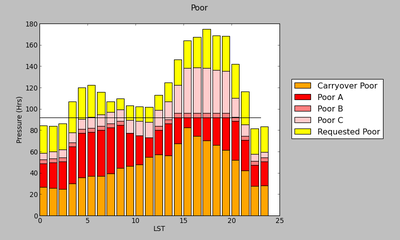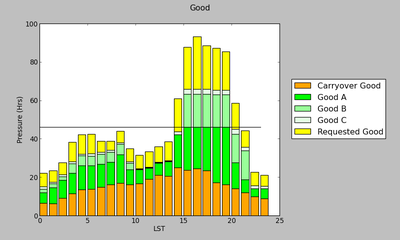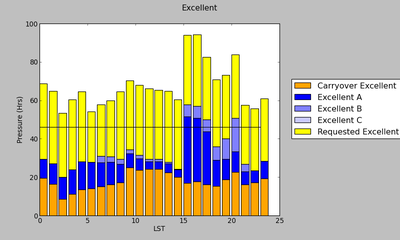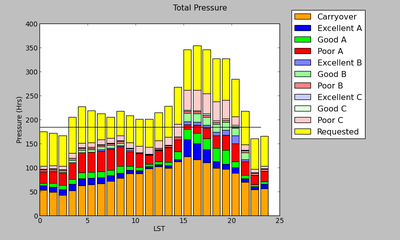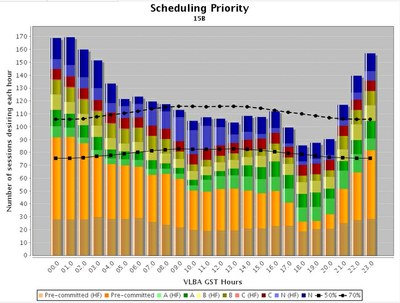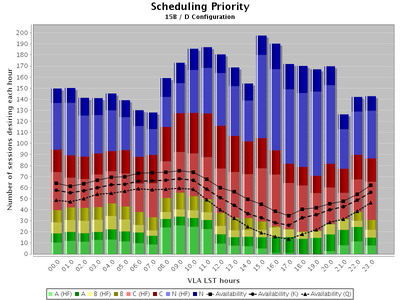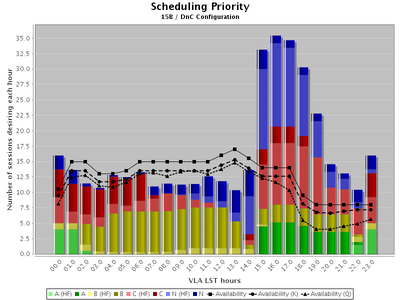15B TAC Report
Summary
A total of 276 proposals were submitted to NRAO's North American facilities for semester 15B. This includes the Robert C. Byrd Green Bank Telescope (GBT), the Very Long Baseline Array (VLBA)/High Sensitivity Array (HSA), and the Karl G. Jansky Very Large Array (VLA). Proposals are reviewed on a competitive basis with a panel review system (see Proposal Review System). Below are the statistics by proposal count and hours. The oversubscription is the ratio of the number of submitted proposals to the number of approved proposals. The pressure is the ratio of the requested time to the available time in hours. Here we only include proposals submitted for the 15B semester that have been reviewed by the NRAO TAC. For the VLA and GBT we count HSA proposal hours that request them as a VLBI station.
| Proposals | GBT | VLBA | VLA | NRAO |
|---|---|---|---|---|
| Submitted | 64 | 40 | 172 | 276 |
| Approved | 25 | 24 | 56 | 105 |
| Filler | 10 | 3 | 58 | 71 |
| Rejected | 29 | 13 | 58 | 100 |
| Oversubscription | 2.6 | 1.7 | 3.1 | 2.6 |
| Proposals | GBT | VLBA | VLA (D) | VLA (DnC) | VLA (Total) | NRAO |
|---|---|---|---|---|---|---|
| Requested | 3964 | 1246 | 3829 | 394 | 4223 | 9433 |
| Available | 2678 | 945 | 1408 | 310 | 1718 | 5341 |
| Approved | 1254 | 797 | 903 | 148 | 1051 | 3102 |
| Filler | 439 | 198 | 1396 | 133 | 1529 | 2166 |
| Rejected | 2271 | 251 | 1530 | 113 | 1643 | 4165 |
| Pressure | 1.5 | 1.3 | 2.7 | 1.3 | 2.5 | 1.8 |
For the 15B semester, the NRAO had agreements with the Hubble Space Telescope (HST) and the Swift Gamma-Ray Burst Mission to submit joint proposals whereby the NRAO TAC could allocate time on these external facilities (see the 15B Call for Proposals). The table below summarizes the results for 15B.
|
HST (Orbits) | Swift (ks) | |
|---|---|---|
| Available | 30 | 300 |
| Requested | 26 | 94.5 |
| Approved | 5 | 66 |
Telescope Pressure Plots
Pressure plots show the total hours of allocated time as a function of LST (or GST for the VLBA) for each telescope. Also shown are how the hours are divided with respect to weather conditions and observing priority. Click on the plot to view the source file.
GBT
The GBT has three weather categories: poor (below 8 GHz), good (between 8-18 GHz and 26.5-50 GHz), and excellent (18-26.5 GHz and above 50 GHz). The first three figures below show the pressure plots for each these weather categories. The last figure includes all weather categories. The grey horizontal line shows the total available hours. The letters A, B, and C correspond to the priorities assigned by the TAC where A and B are approved time and C is filler time. Carryover is time allocated by a TAC from a previous semester that is being executed in the 15B semester.
VLBA
The VLBA has two weather categories: high frequency (above 12 GHz, light shading) and low frequency (below 12 GHz, dark shading). The two black lines are 50% (solid) and 70% (dashed) of the time available, respectively. The letters A, B, C, and N correspond to the priorities assigned by the TAC where A and B are approved time, C is filler time, and N is rejected time. Pre-committed (carryover) time is time allocated by a TAC from a previous semester that is being executed in the 15B semester.
VLA
The VLA has two weather categories: high frequency (above 12 GHz, light shading) and low frequency (below 12 GHz, dark shading). The two figures below show the pressure for the D and DnC configurations. The black lines indicate the total time available for science (solid), the time available for K-band and higher and higher frequencies (dashed), and the time available for Q-band (dotted). The letters A, B, C, and N correspond to the priorities assigned by the TAC where A and B are approved time, C is filler time, and N is rejected time.
Observation Preparation
GBT
Please use the GBT Dynamic Scheduling System (DSS) to enable observing sessions, select observers for your project, and enter your blackout dates. The DSS Home Page has additional information about the DSS. See GBT Observing for information about how to prepare for your observations.
Please note that the DSS uses the average Right Ascension (RA) and Declination (Dec) of all sources within a session. The average RA and Dec will be used to determine when the session can be scheduled. You will need to carefully check the RA and Dec, along with the minimum and maximum session lengths, to make sure that these values are satisfactory and will allow all your sources to be observed before enabling the session.
VLBA
In semester 15B, Galactic parallax projects require much of the VLBA time in inner Galaxy GSTs (~2100 - 0400 GST) in the parallax "season", which is approximately +/-3 weeks centered on the equinoxes. Twenty-four hour blocks are very difficult to schedule during that time. If at all possible, dynamic blocks should avoid those GSTs during that time of the year.
IMPORTANT: Those allocated dynamic time should begin their .key file preparation about two weeks before 2015 August 1, the start of semester 2015B.
Any approved time may be divided into multiple scheduling blocks as appropriate, considering the scheduling priority, observing frequency, GST range suitable for the targets, and GST pressure. For advice on preparing your scheduling blocks, please consult VLBA Observing.
VLA
In semester 15B daytime maintenance activities peak at about 16 hours LST, so proposal pressure is highest there. Those allocated dynamic time should begin their scheduling block preparation about two weeks before the planned start of the configuration (See Configuration Plans).
Any approved time may be divided into multiple scheduling blocks as appropriate, considering the scheduling priority, observing frequency, LST range suitable for the target(s), and LST pressure. For advice, please consult the VLA Observing Guide.
Unless stated otherwise, any time allocated is only for the identified proposal, and no modification in the project should be made without obtaining permission from NRAO scheduling staff. To seek permission, submit a ticket to the Proposal Review department of the NRAO Helpdesk.

